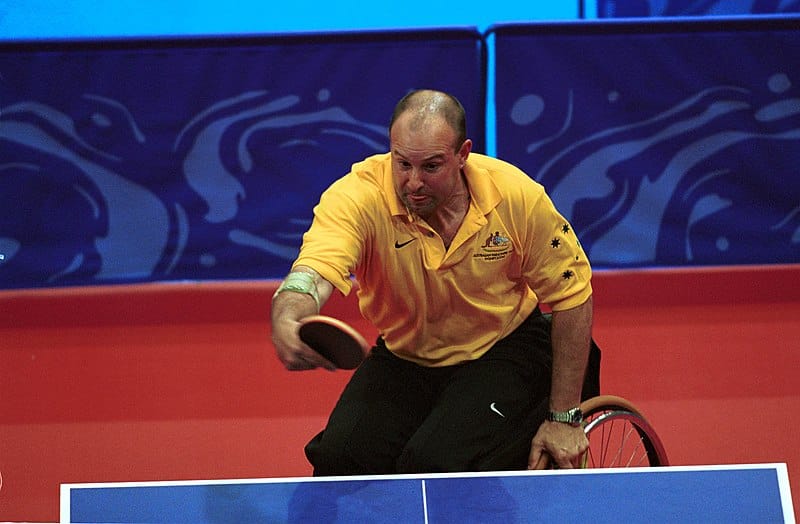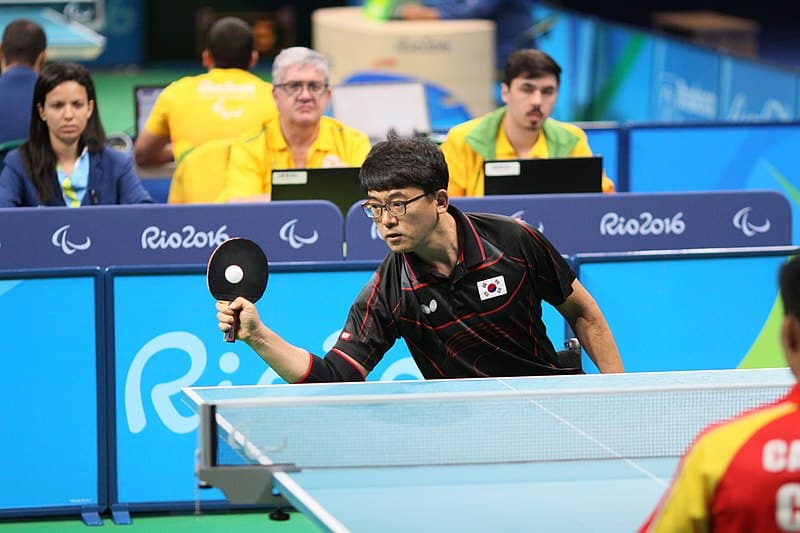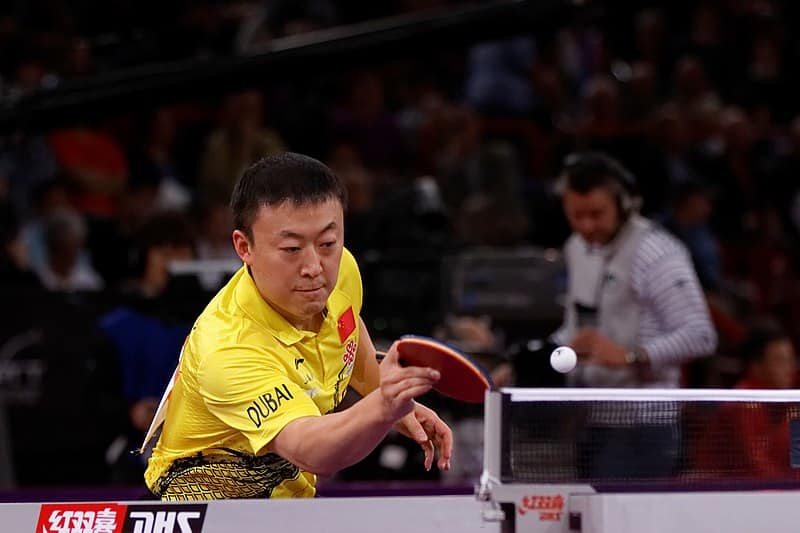Every player has a style, even those who are playing for the first time. Naturally, beginners are more cautious and tend to slot within a defensive style, but as we look at more advanced players, we start to see a diverse range of styles and strategies.
Of course, many table tennis players don’t fit perfectly into specific categories, yet while this is true, most will broadly fit into one style category.
The 7 main table tennis styles include:
- Looping Attacker
- Flat-Hitting Attacker
- Short Pimple Attacker
- Controlled Attacker
- All-Arounder
- Blocker
- Defender
Table of Contents
ToggleThe 7 Most Common Table Tennis Styles
1. Looping Attacker
The looping attacker dominates at the top of the sport today, and as such, the playing style is extremely prevalent among skilled amateurs as well.
The objective of the looping attacker is to end the point as quickly as possible using fast loops that are loaded with topspin. Due to this fact, most players of this style prefer the forehand because it is more explosive.
In fact, within this table tennis style of play, there is a sub-style called the one-winged looper.
One-winged-loopers heavily favor the forehand side and may not even loop on the backhand side at all. To make up for their weaker backhand, many players have excellent footwork to ensure that they can play forehand shots as much as possible.
While the favoritism for the forehand side is certainly there, most skilled looping attackers have a fairly dangerous backhand loop. So don’t only watch out for the forehand! Their backhand attack is plenty deadly in its own right.
Strengths
- Fast
- Spinny
- Strong serves
- Great footwork
- Can loop backspin easily
Weaknesses
- May struggle against long pimples
- Can get caught out by wide balls on the forehand
- Tendency to stand too far away from the table
2. Flat-Hitting Attacker

While flat-hitting attackers are technically not flat-hitting the ball as they are producing topspin, their angle is very direct. Much more so than loopers. This means that they are only producing light topspin.
Rather than heavy spin, the flat-hitting style revolves around power. These table tennis players hit the ball at the top of the bounce and have blistering speed. They can easily punish balls that pop up a little too high, and many will even be effective at smashing through backspin.
Yet, while they can attack high backspin balls, they’re stuck with low backspin balls as they cannot loop the ball. This means you can easily stall a flat-hitter’s game by pushing the ball — they match up very poorly with the pushing style. Instead, they love playing a topspin game. They match up best against blockers and controlled attackers.
They also struggle too much if you pin the ball to their backhand corner, as they can’t employ their more powerful forehand attack.
Strengths
- Very fast
- Flourish in topspin rallies with light to moderate topspin
- Punishing high balls
Weaknesses
- Cannot loop the ball
- Weaker backhand
- Return of serve
3. Short Pimple Attacker
Nowadays, we have fewer players who use this fast and aggressive style. Short pimples attackers stand close to the table and attack the ball at its highest point — they are a bit like flat hitters in this way.
They do not drift away from the table because they don’t produce much topspin, so the ball does not have much of an arc.
When playing against a short pimple attacker, it is essential to keep yourself safe by playing the ball low over the net — they can’t attack these balls, and if they do, they will lose far more points than they win.
Also, use spin to force them away from the table. Deep heavy topspin and backspin balls are very effective at countering the short pimple attacking style.
Strengths
- Cracking smashes
- Will punish poor-quality shots
Weaknesses
- Not that consistent
- Deep balls
- Low balls
4. Controlled Attacker

Controlled attackers are masters of consistency and patience. They rarely make unforced errors and are content to let rallies play out which can be frustrating for certain opponents. While these are excellent qualities to possess, they also have their drawbacks.
Controlled attackers are highly risk-averse, which means they always err on the side of caution, even when golden opportunities present themselves for a point-ending shot. What’s more, some controlled attackers lack top-end speed, so they can struggle to put the ball away.
On the other hand, the versatility of such players can make them challenging to play against. With such a diverse arsenal of shots, a high-IQ-controlled attacker can make your life very difficult. A great way to counter their style is to match their patience and consistency and attack the weaker balls they send your way.
For instance, manageable counter drives are the perfect shots to try and put away, and these are a core component of a controlled attackers’ arsenal. Fun fact: some controlled attackers focus on this shot more than others. We call these players counter-drivers.
Strengths
- Patient
- Consistent
- Versatile
Weaknesses
- Risk-averse, which can ultimately lose them points
- May lack top-end power
- While shots are safe, many styles can counter them
5. All-Arounder
I tend to think of all-rounders as a jack of all trades and masters of none. They are equally content attacking or defending, and as a result, they match up fairly well against most styles and don’t have any glaring issues that you can exploit.
The style is remarkably similar to the controlled attacker, with more of a focus on defense. This means they also lack the top-end power needed to finish the ball.
Most of the time, the best course of action against an all-rounder is just playing your regular game. As they are skilled across the board but not exceptional in any one area, you should outperform them in your favored style. For instance, if you push the ball, force pushing rallies as much as possible, as you should be stronger in this area.
Strengths
- Patient
- Consistent
- Versatile
- No glaring holes in their game
Weaknesses
- Not particularly strong in any area
- May lack top-end power
6. Blocker

While blocking is one of the most common shots in table tennis today, you rarely see elite players adopt a blocking-heavy style of play. This is because a quality looper almost always beats a quality blocker.
Instead, you’ll see blockers more often at the local club and league level. As table tennis players age, they generally become more defensive, so you should see your fair share of older blockers.
They are highly consistent and precise, and due to the block not demanding good levels of footwork, they can cover the table much better than you would expect.
Blockers can sometimes feel like an impenetrable wall that won’t budge no matter what you throw at them. However, the style does have a lot of issues. The main one is that you can easily overwhelm them with more spin or speed than they can handle.
They are also very passive and rarely take the initiative to attack the ball, instead relying on their opponents to make a mistake. So if you play smart and attack the right balls with conviction, you should win most of the time.
Strengths
- Consistent
- Precise
- Can unexpectedly attack
Weaknesses
- Rely on opponents to make a mistake
- Can be overwhelmed by too much spin or speed
- Lack power
- Poor footwork
7. Chopper

Chopping is the ultimate form of defense in table tennis, and while there aren’t many choppers at the top of the sport like there used to be, it’s still a very powerful style.
Choppers like to play against offensive players and are both consistent and patient. They win rallies by frustrating their opponents and waiting for mistakes to occur. One of the main weaknesses of chopping is allowing the opponent to attack for free, which is a bad idea if you are facing an elite attacker.
You should be aware of a few different table tennis playing styles for chopping. The first involves using regular inverted rubbers. These cause the ball to behave in a normal way.
However, chopping with pimples is extremely common within this style. Pimple rubbers cause the ball to behave irregularly. With this
You may also come across attacking choppers. These players chop the ball and wait for a mistake to start attacking. You really have to stay on your toes against this style — they are often harder to play against than players who just chop the ball.
Strengths
- Consistent
- Patient
- Good at frustrating opponents
- Hard to hit winners against
Weaknesses
- Allow opponents to attack for free
- Rely on mistakes from their opponents
- Usually not very effective at attacking shots
Read More: Best Table Tennis Rackets
Other Conditions to Consider
Backhand vs Forehand Dominant
Beyond considering the ping pong style of the type of player you are facing off against, you should also consider if they favor either their backhand side or forehand. Almost all players have a slight preference. And almost always, that preference is for the forehand.
So why does this matter, you might ask?
Well, it’s for the same reason their style matters. You need to know where they are strong and where they are weak. A player with strong favoritism for one side means they have a weaker side that you can exploit.
For forehand dominant players, especially loopers, you can trouble them by working the table well. Try pushing long to their backhand side to bait out a forehand loop. This opens up their forehand side for a precise counter.
Shakehand vs Penhold Grip

A player’s grip tells you a lot about how they play before they’ve even started hitting the ball. Shakehanders have much better backhands than penhold players, the grip is also more versatile allowing for the likes of backhand chops.
Penhold, on the other hand, is more specialized. These types of players have strong forehands and great footwork to ensure they use their forehands as much as possible. Furthermore, these players usually have great serves and are fairly spinny.
Most penhold grip styles are offensive in nature. However, there are penhold blockers around. You won’t find penhold style choppers because chopping is a fundamental weakness of the grip.
How to Identify a Table Tennis Style
Identifying a playing style in table tennis is a fairly easy job. You should be able to nail down a player’s strategy by the end of your knock-up before the match begins.
First things first, look at their grip. As mentioned above, a grip says a lot about a player. Then when you get into the knock-up, pay attention to what type of shots they are hitting. Are they using topspin or backspin?
Once you’ve recognized this, dig a little deeper. For instance, are they consistently attacking every ball or only attacking intermittently? This could be the difference between a controlled attacker and an all-round player.
So What Is the Best Playing Style in Table Tennis?
Ultimately, you should choose the table tennis style that fits your preferred method of play the best. Not only will you be able to refine this style quicker, but you’ll also have more fun playing.
That being said, if we purely look at performance, the looping attacker wins by a landslide. The vast majority of professionals use this ping pong style as it is the most versatile attacking option. It both enables you to take the initiative in a match and adapt your strategy to the type of opponent you are facing. We can’t say the same for the likes of short pimple attacking which players can easily counter.
To learn more about styles, read our alternative guide here.










